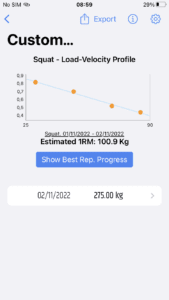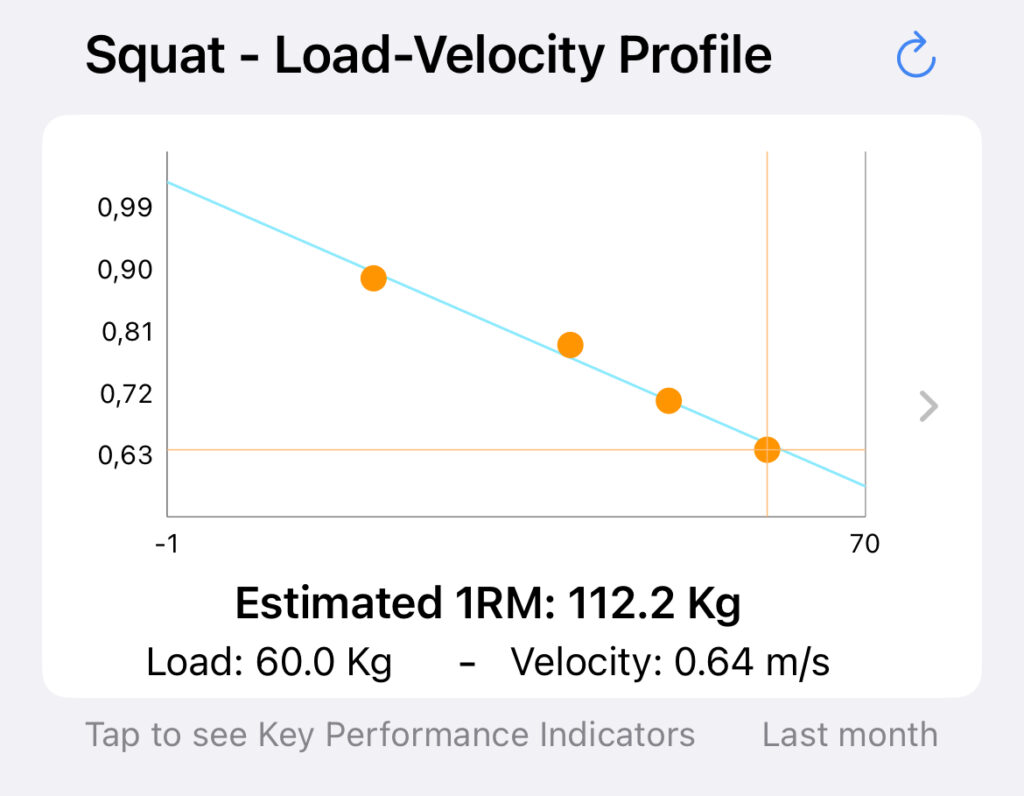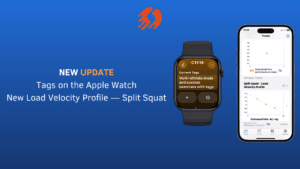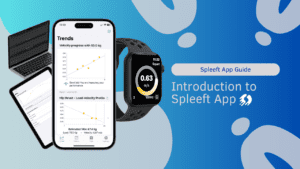Learn more about autoregulation in our post about Z-Scores in VBT.
Estimating the maximum repetition in an exercise was one of the first options provided by the VBT. It’s also one of the most used nowadayss. It helps us to know the most basic when training in the gym: the weight to put on the bar. The first version of Spleeft (on Android) included the option of a load-velocity profile and a daily estimate of 1RM. However, this becomes very time-ineffective in day-to-day training. Therefore, the latest versions of Spleeft perform both tasks automatically, if the basic conditions are met.
DOWNLOAD SPLEEFTAPP FOR PHONE AND WATCH NOW!
INTRODUCTION
Automatic Load-Velocity Profile and 1RM Estimation with Spleeft
At first, the work of González-Badillo and Sánchez-Medina (1) and successive replications in other exercises were proposed as general load-velocity profiles to estimate 1RM, as a very high correlation was found between relative load (%RM) and execution velocity. Successive studies have shown that the relationship between relative load and velocity undergoes large inter-individual variations due to age, gender and even intra-individual variations over a training period (2). Other factors such as exercise, execution technique and even the measuring device can also affect this relationship.
To overcome the above limitations, individual load-velocity profiles were created. That is the result of performing an incremental test with 5 loads between 40-95% of the estimated 1RM. With that, a linear regression is performed and the load that would represent the 1RM is estimated with the minimum velocity threshold or velocity at which the 1RM is lifted (3).
Knowing the MVT is indispensable for estimating the 1RM by means of the load-velocity relationship. This is a major problem, since its measurement requires a maximum or traditional 1RM test, reaching failure. This value is specific to each exercise, due to the differences in the muscles recruited and their characteristics (inter-intramuscular coordination, size of motor neurons, etc.). The MVT is the most stable value within the load-velocity relationship. Normative values have been investigated for the main strength exercises (de Hoyo et al., 2021; Ruf et al., 2018; Sánchez-Medina et al., 2017). However, it has also been shown that it can vary between athletes (4) and even during the same training period (2). Therefore, although previous studies have shown that the creation of individualized load-velocity profiles is valid, their accuracy would be increased by knowing the athlete’s MVT. In practice, the use of a generic MVT is assumed to be valid.
HOW DOES THE AUTOMATIC LOAD-VELOCITY PROFILE WORK?

By scrolling to the right in the VBT history, you can see your load-velocity profile for the exercise and date range you have selected in the settings (top right). It is not recommended to choose date ranges longer than 3 months. During that period, you may have gained or lost certain training adaptations, depending on whether you have followed a training plan or not. Therefore, a maximum of 3 months will give you an overview of your current training status.
The conditions for Spleeft to create a load – velocity profile automatically are as follows:
- At least one load must be above 80% of the 1RM. We must be close to what we want to measure for the measurement to be accurate.
- The loads must be at least 5 kg apart. This will give you a better overview of your entire profile.
- There must be a high correlation (r2>0.9). If there are several groups of loads that follow this condition, Spleeft will keep the set of 3–4 loads with the highest correlation.
- Finally, 3 or 4 loads meet the above conditions.
Do you think the algorithm should include any other conditions? Let us know!
Spleeft will filter all your training data. Then it finds all the loads you have worked with and the highest velocity at which they have been moved. Based on the above conditions, if possible, it will show you your load – velocity profile and your estimated 1RM.
To estimate the 1RM, first, a linear regression is performed between the load and velocity values. After that, the 1RM weight is predicted with the theoretical velocity at which it moves (MVT). This can be done with traditional spreadsheets.
What if you want to perform a load – velocity profile assessment session and observe it on the graph? To do this, one trick is to go to the graph settings and, under date range, select custom. Two fields will appear, where you must select, both of them, on the day of the test. If all conditions were met, Spleeft will show it on the chart.
HOW DOES THE AUTOMATIC DAILY 1RM ESTIMATION WORK?

Once you have your load – velocity profile set up, you can know what weight to put on the bar. However, the 1RM may vary from day to day due to your fitness level or the immense number of factors that condition fatigue, so you may need to raise/lower the weight on the bar to adjust it to your objective.
So, after clicking on the history on the day you trained, Spleeft estimates your daily 1RM, so you know exactly what weight to put on the bar each day. All the loads used that day on the exercise selected in the settings are filtered out, choosing the best velocity obtained with the highest load. The closer to the 1RM, the more accurate the measurement will be.
With this data, Spleeft checks in your load – velocity profile what %RM the previous load supposes to you. For example: 0.6 m/s is 60% of your 1RM. If you have managed to lift 60kg at 0.6 m/s, that load is your today’s 60%. A simple triangulation is all it takes to find out what load gives you 100%RM.
Spleeft also makes sure to inform you whether this data is reliable. In the scientific literature, daily variations of up to 18% (5) have been reported in powerlifters who accumulated a lot of fatigue in each session. Therefore, if your estimated 1RM for today differs from your estimated 1RM in the profile by more than 15%, you will receive a warning of low reliability of the estimate.
In case you have not done enough training to have an individualized load – velocity profile, Spleeft will give you your daily 1RM based on a generic profile from the scientific literature. As in the previous situation, you will be warned that this method, especially when performed at low loads, is not very accurate as there is individual variation.
REFERENCES
- González-Badillo JJ, Sánchez-Medina L. Movement velocity as a measure of loading intensity in resistance training. Int J Sports Med [Internet]. 2010 [cited 2021 Jul 26];31(5):347–52. Available from: https://pubmed.ncbi.nlm.nih.gov/20180176/
- Balsalobre-Fernández C, García-Ramos A, Jiménez-Reyes P. Load–velocity profiling in the military press exercise: Effects of gender and training: International Journal of Sports Science & Coaching [Internet]. 2017 Oct 26 [cited 2022 Mar 10];13(5):743–50. Available from: https://journals.sagepub.com/doi/abs/10.1177/1747954117738243
- Jidovtseff B, Harris N, Crielaard J, Cronin J. Using the load-velocity relationship for 1RM prediction. J Strength Cond Res [Internet]. 2011 Jan [cited 2021 Sep 30];25(1):267–70. Available from: https://pubmed.ncbi.nlm.nih.gov/19966589/
- Banyard H, Nosaka K, Vernon A, Haff G. The Reliability of Individualized Load-Velocity Profiles. Int J Sports Physiol Perform [Internet]. 2018 Jul 1 [cited 2021 Jul 26];13(6):763–9. Available from: https://pubmed.ncbi.nlm.nih.gov/29140148/
- Zourdos MC, Dolan C, Quiles JM, Klemp A, Jo E, Loenneke JP, et al. Efficacy of daily one-repetition maximum training in well-trained powerlifters and weightlifters: a case series. Nutrición hospitalaria: Organo oficial de la Sociedad española de nutrición parenteral y enteral, ISSN 0212-1611, Vol 33, No 2 (Marzo-Abril 2016), 2016, págs 437-443 [Internet]. 2016 [cited 2021 Dec 2];33(2):437–43. Available from: https://dialnet.unirioja.es/servlet/articulo?codigo=6147117&info=resumen&idioma=ENG
Spleeft is available for iOS and Android here.







One Comment
Pingback:Calculate your 1RM with Velocity: Strength Training Revolved